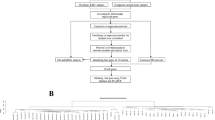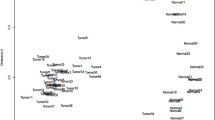Abstract
Identification of cancer subtypes based on molecular knowledge is crucial for improving the patient diagnosis, prognosis, and treatment. In this work, we integrated copy number variations (CNVs) and transcriptomic data of Kidney Papillary Renal Cell Carcinoma (KIRP) using a network diffusion strategy to stratify cancers into clinically and biologically relevant subtypes. We constructed GeneNet, a KIRP specific gene expression network from RNA-seq data. The copy number variation data was projected onto GeneNet and propagated on the network for clustering. We identified robust subtypes that are biologically informative and significantly associated with patient survival, tumor stage and clinical subtypes of KIRP. We performed a Singular Value Decomposition (SVD) analysis of KIRP subtypes, which revealed the genes/silent players related to poor survival. A differential gene expression analysis between subtypes showed that genes related to immune, extracellular matrix organization, and genomic instability are upregulated in the poor survival group. Overall, the network-based approach revealed the molecular subtypes of KIRP and captured the relationship between gene expression and CNVs. This framework can be further expanded to integrate other omics data.







Similar content being viewed by others
Availability of supporting data
All data generated or analysed during this study are included in this published article. Code is available in: https://github.com/Cancer-Research-Project/NBS-KIRP-CNV.
References
AACR Project GENIE Consortium (2017) Aacr project genie: powering precision medicine through an international consortium. Cancer Discov 7:818–831
Aubert N, Brunel S, Olive D et al (2021) Blockade of hvem for prostate cancer immunotherapy in humanized mice. Cancers 13:3009
Barrett T, Wilhite SE, Ledoux P et al (2013) NCBI GEO: archive for functional genomics data sets-update. Nucleic Acids Res 41:D991–D995
Bhaskaran N, Liu Z, Saravanamuthu SS et al (2018) Identification of casz1 as a regulatory protein controlling t helper cell differentiation, inflammation, and immunity. Front Immunol 9:184
Brunet JP, Tamayo P, Golub TR et al (2004) Metagenes and molecular pattern discovery using matrix factorization. Proc Natl Acad Sci USA 101:4164–4169
Cai D, He X, Wu X, et al (2008) Non-negative matrix factorization on manifold. In: 8th IEEE Int Conf Data Mining, p 63–72
Carter S, Eklund A, Kohane I et al (2006) A signature of chromosomal instability inferred from gene expression profiles predicts clinical outcome in multiple human cancers. Nat Genet 38:1043–1048
Cui M, Liu D, Xiong W et al (2021) Errfi1 induces apoptosis of hepatocellular carcinoma cells in response to tryptophan deficiency. Cell Death Discov 7:274
Delahunt B, Eble JN (1997) Papillary renal cell carcinoma: a clinicopathologic and immunohistochemical study of 105 tumors. Modern Pathol Off J U. S. Can Acad Pathol Inc 10:537–544
Forbes SA, Beare D, Boutselakis H et al (2017) Cosmic: somatic cancer genetics at high-resolution. Nucleic Acids Res 45:D777–D783
Frazzi R (2021) Birc3 and birc5: multi-faceted inhibitors in cancer. Cell Biosci 11(1):1–14
Fujimoto A, Furuta M, Totoki Y et al (2016) Whole-genome mutational landscape and characterization of noncoding and structural mutations in liver cancer. Nat Genet 48:500–509
Gonzalez H, Hagerling C, Werb Z (2018) Roles of the immune system in cancer: from tumor initiation to metastatic progression. Genes Dev 32:1267–1284
Hanahan D, Weinberg RA (2011) Hallmarks of cancer: the next generation. Cell 144:646–674
He Z, Zhang J, Yuan X et al (2017) Network based stratification of major cancers by integrating somatic mutation and gene expression data. PLoS One 12(e0177):662
Hofree M, Shen JP, Carter H et al (2013) Network-based stratification of tumor mutations. Nat Methods 10:1108–1115
Huang JK, Carlin DE, Yu MK et al (2018a) Systematic evaluation of molecular networks for discovery of disease genes. Cell Syst 6:484–495
Huang JK, Jia T, Carlin DE et al (2018b) pynbs: a python implementation for network-based stratification of tumor mutations. Bioinformatics 34:2859–2861
Iorio F, Knijnenburg TA, Vis DJ et al (2016) A landscape of pharmacogenomic interactions in cancer. Cell 166:740–754
Irizarry RA, Hobbs B, Collin F et al (2003) Exploration, normalization, and summaries of high density oligonucleotide array probe level data. Biostatistics 4:249–264
Karner CM, Das A, Ma Z et al (2011) Canonical wnt9b signaling balances progenitor cell expansion and differentiation during kidney development. Development 138(7):1247–1257
Kohli K, Pillarisetty VG, Kim TS (2022) Key chemokines direct migration of immune cells in solid tumors. Cancer Gene Ther 29:10–21
Kuleshov MV, Jones MR, Rouillard AD et al (2016) Enrichr: a comprehensive gene set enrichment analysis web server 2016 update. Nucleic Acids Res 44:W90–W97
Kumari N, Dwarakanath BS, Das A et al (2016) Role of interleukin-6 in cancer progression and therapeutic resistance. Tumour biology J Int Soc Onco Dev Biol Med 37:11,553-11,572
Kundu A, Nam H, Shelar S et al (2020) Prdm16 suppresses hif-targeted gene expression in kidney cancer. J Exp Med 217(e20191):005
Lee D, Seung H (1999) Learning the parts of objects by non-negative matrix factorization. Nature 401:788–791
Li M, Ren H, Zhang Y et al (2022) Mecom/prdm3 and prdm16 serve as prognostic-related biomarkers and are correlated with immune cell infiltration in lung adenocarcinoma. Front Oncol 12:772686
Liao C, Wang Q, An J et al (2022) Spinks in tumors: potential therapeutic targets. Front Oncol 12(833):741
Linehan WM, Spellman PT, Ricketts CJ et al (2016) Comprehensive molecular characterization of papillary renal-cell carcinoma. N Engl J Med 374:135–145
Liu Z, Zhang S (2015) Tumor characterization and stratification by integrated molecular profiles reveals essential pan-cancer features. BMC Genom 16:503
Love MI, Huber W, Anders S (2014) Moderated estimation of fold change and dispersion for rna-seq data with deseq2. Genome Biol 15:550
Luo L, Zhou H, Su H (2021) Identification of 4-genes model in papillary renal cell tumor microenvironment based on comprehensive analysis. BMC Cancer 21:553
Ma M, Zhang Z, Liu Y et al (2022) Preliminary study on the role of the c5orf46 gene in renal cancer. Transl Oncol 21(101):442
Masjedi A, Hashemi V, Hojjat-Farsangi M et al (2018) The significant role of interleukin-6 and its signaling pathway in the immunopathogenesis and treatment of breast cancer. Biomed Pharmacother 108:1415–1424
Matsuda Y, Miura K, Yamane J et al (2016) Serpini1 regulates epithelial-mesenchymal transition in an orthotopic implantation model of colorectal cancer. Cancer Sci 107(5):619–628
Monti S, Tamayo P, Mesirov J et al (2003) Consensus clustering: a resampling-based method for class discovery and visualization of gene expression microarray data. Mach Learn 52:91–118
Pandey N, Lanke V, Vinod PK (2020) Network-based metabolic characterization of renal cell carcinoma. Sci Rep 10:5955
Revel M, Daugan MV, Sautés-Fridman C et al (2020) Complement system: promoter or suppressor of cancer progression? Antibodies (Basel) 9:57
Roumenina LT, Daugan MV, Noé R et al (2019) Tumor cells hijack macrophage-produced complement c1q to promote tumor growth. Cancer Immunol Res 7:1091–1105
Seifert M, Beyer A (2018) regnet: an r package for network-based propagation of gene expression alterations. Bioinformatics 34:308–311
Senbabaoglu Y, Michailidis G, Li J (2014) Critical limitations of consensus clustering in class discovery. Sci Rep 4:6207
Singh NP, Vinod PK (2020) Integrative analysis of dna methylation and gene expression in papillary renal cell carcinoma. Mol Genet Genom 295:807–824
Singh NP, Bapi RS, Vinod PK (2018) Machine learning models to predict the progression from early to late stages of papillary renal cell carcinoma. Comput Biol Med 100:92–99
The Cancer Genome Atlas Research Network (2011) Integrated genomic analyses of ovarian carcinoma. Nature 474:609–615
The Cancer Genome Atlas Research Network (2012) Comprehensive molecular portraits of human breast tumours. Nature 490:61–70
Vandin F, Upfal E, Raphael BJ (2011) Algorithms for detecting significantly mutated pathways in cancer. J Comput Biol J Comput Mol Cell Biol 18:507–522
Verhaak RG et al (2010) Integrated genomic analysis identifies clinically relevant subtypes of glioblastoma characterized by abnormalities in pdgfra, idh1, egfr, and nf1. Cancer Cell 17:98–110
Vogelstein B, Papadopoulos N, Velculescu VE et al (2013) Cancer genome landscapes. Science (New York, NY) 339:1546–1558
Wang Z, Song Q, Yang Z et al (2019) Construction of immune-related risk signature for renal papillary cell carcinoma. Cancer Med 8:289–304
Wu L, Liu Z, Xu J et al (2015) Netbags: a network-based clustering approach with gene signatures for cancer subtyping analysis. Biomark Med 9:1053–1065
Xu Y, Kong D, Li Z et al (2021) Screening and identification of key biomarkers of papillary renal cell carcinoma by bioinformatic analysis. PLoS One 16(e0254):868
Yan L, Zhang Y, Ding B et al (2019) Genetic alteration of histone lysine methyltransferases and their significance in renal cell carcinoma. PeerJ 7:e6396
Zhao L, Lee VHF, Ng MK et al (2019) Molecular subtyping of cancer: current status and moving toward clinical applications. Brief Bioinform 20:572–584
Zhong X, Yang H, Zhao S et al (2015) Network-based stratification analysis of 13 major cancer types using mutations in panels of cancer genes. BMC Genomics 16:S7
Acknowledgements
This work was supported by iHUB-Data, International Institute of Information Technology, Hyderabad, India.
Funding
Not applicable
Author information
Authors and Affiliations
Contributions
Conceptualization: PKV; methodology: KSS, AJ, MB; formal analysis and investigation: KSS, AJ, MB; writing—original draft preparation: KSS; writing—review and editing: KSS, AJ, MB, PKV; funding acquisition: PKV; supervision: PKV.
Corresponding author
Ethics declarations
Conflict of interest
The authors have declared that no competing interests exist.
Ethical approval and consent to participate
Not applicable.
Human and animal ethics
Not applicable.
Consent for publication
Not applicable.
Additional information
Publisher's Note
Springer Nature remains neutral with regard to jurisdictional claims in published maps and institutional affiliations.
Supplementary Information
Below is the link to the electronic supplementary material.
Rights and permissions
Springer Nature or its licensor (e.g. a society or other partner) holds exclusive rights to this article under a publishing agreement with the author(s) or other rightsholder(s); author self-archiving of the accepted manuscript version of this article is solely governed by the terms of such publishing agreement and applicable law.
About this article
Cite this article
Shetty, K.S., Jose, A., Bani, M. et al. Network diffusion-based approach for survival prediction and identification of biomarkers using multi-omics data of papillary renal cell carcinoma. Mol Genet Genomics 298, 871–882 (2023). https://doi.org/10.1007/s00438-023-02022-4
Received:
Accepted:
Published:
Issue Date:
DOI: https://doi.org/10.1007/s00438-023-02022-4




